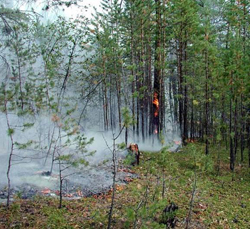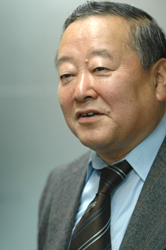Forests help absorb carbon dioxide (CO2), and are thought to mitigate global warming. In particular, the vast Russian Siberian Taiga (coniferous forest zone) has been said to be the world's largest absorber of CO2. Recently, however, there have been frequent forest fires, which have instead resulted in the emission of CO2. In addition, when there are forest fires in Siberia, this melts the permafrost, releasing large quantities of methane gas, which is an even more serious cause of global warming than CO2.
In order to prevent forest fires in Siberia, Hokkaido University, the University of Alaska, and the Russian Academy of Sciences have cooperated on fire discovery and control measures. In 2003, we began cooperating in the detection and reporting of forest fires, using aircrafts that fly over Siberia. We are making a contribution to society that is only possible for us as an airline and as pilots.

Increasing the Accuracy of Fire Detection using both Satellites and Aircraft
In Siberia, 20 million hectares, or about half the total area of Japan burn in forest fires in most years, releasing huge amounts of CO2 into the atmosphere. For example, one hectare of burned Siberian Taiga emits the equivalent of about 40 tons of carbon. However, the amount that can be absorbed by surrounding forest is only about 0.4 tons per hectare. Thus, unless the forest is 100 times the size of the burned area, the released CO2 cannot be absorbed. In addition, after an area has been burned, the trees in that area are lost, and the CO2 takes several decades to come out through soil respiration. Then for several decades or even for several centuries, the melting permafrost releases methane gas. Counting all of this together, when the Siberian Taiga is affected by fire, it goes from being a sink for greenhouse gases, to being a source of emissions.
In order to stop this, it is first necessary to suppress forest fires. However, the Siberian Taiga region has an area of about 20 times the area of Japan, and human power alone is not sufficient to find fires in such a huge area. Using satellites is the most effective method. Currently, NASA satellites are used to detect fires, but sometimes there are errors due to defects. In order to prevent these errors, ground information is combined with the satellite information and adjustments are made. There are several ways to collect ground information, including walking around the ground, or using aircraft. Using aircraft to cover areas that cannot be covered by forest fire prevention ground forces, data can be obtained for a wider area, and monitoring by aircraft thus plays a very important role. It is also advantageous that JAL European routes fly over this area on a regular basis. Because variations in the same area over a long period of time can be observed in this way, it is very helpful to our research.

Hokkaido University
Professor Emeritus Masami Fukuda
The Concept of "Let's Do What We Can for the Environment"
In April 2006, an Environmental Committee was established in our Operations Dept. This organization began from volunteer activities based on the question of whether there was something that pilots could do for the environment. As pilots, we regularly fly in aircrafts that use a lot of fuel. How much fuel can be saved is one issue for the environment, and we have expanded our activities to research environmentally friendly ways to fly, and to engage in educational activities. We have also worked on initiatives to detect forest fires in Siberia, as another way that we can work to conserve the environment. This is not directly connected to our jobs, but since we are the only ones that can make such reports from the sky, and after hearing from Dr. Fukuda at Hokkaido University, we began participating with the strong desire to do what we can for the environment. When flying at an altitude of 10,000 meters, if conditions are good with clear weather, we can look out over an area of 400 square kilometers. If smoke is seen, it is reported immediately, and since we know the position where we are flying at that time, we can use this as the basis of determining where the smoke is coming from. Initially individuals on pilots made the reports themselves, but now there is a uniform reporting format, which has been devised and improved so that it can be filled in quickly. This concept of "let's do what we can for the environment" has been passed down to the "Sky Eco Project" of the Operations Dept.

Captain Hideki Kudo
* This statement was developed based on conversations with 4 captains that are members of the Environmental Committee.
| Implementation Period | Number of Reports |
|---|---|
| May - August 2005 | 30 |
| June - August 2006 | 138 |
| June - September 2007 | 172 |
| June - September 2008 | 263 |
| June - October 2009 | 158 |
| July - September 2010 | 51 |
Including routes to Europe and the US, and Southeast Asia.